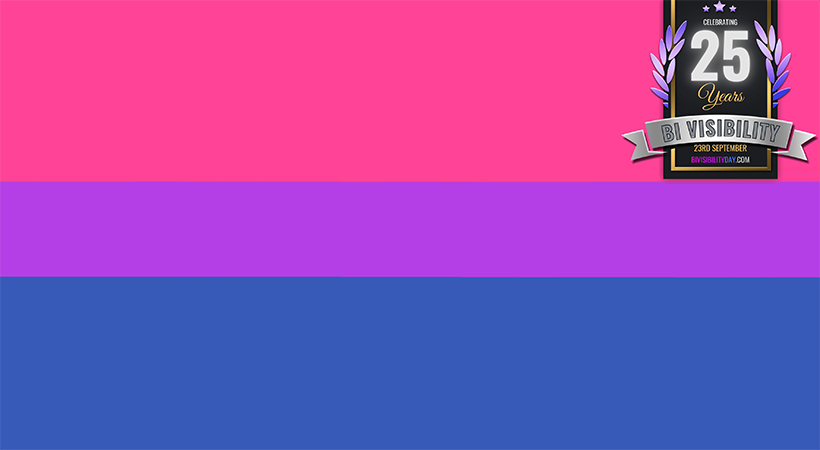What began as a spontaneous party held by three bisexual activists is now the culmination of a week-long international affair: Bi+ Visibility Day and Bisexual Awareness Week. That’s a big deal!
Some folks hold incorrect assumptions about bi+ people, such as:
- Bisexual men are actually gay
- Bi+ people are more promiscuous, confused or don’t know what they want
- Bi+ people are more likely to cheat on their partner
- All bi+ people are polyamorous
- Bi+ people don’t face as much stigma as gay or lesbian people
The combined effect of language and pervasive myths create a stigma that can leave bi+ people feeling invisible in all communities.
Emen8 is committed to increasing visibility for bi+ guys. So, here’s our guide to Bi+ Visibility Day and why it’s a must-have on your annual calendar.
What is Bi+ Visibility Day?
Bi+ Visibility Day, also known as Celebrate Bisexuality Day, is an international movement, observed annually on September 23. It was created by three American bisexual activists: Wendy Curry of Maine, Michael Page of Florida, and Gigi Raven of Wilbur, Texas.
The observance celebrates bisexual people and their achievements, as well as bisexual history and culture. It recognises the unique challenges of those identifying as bisexual, such as bi-erasure, and facilitates conversations to increase their visibility in the community.
In its present form, Bi+ Visibility Day is the culmination of the weeklong event: Bisexuality Awareness Week.

What does Bi+ mean?
The term ‘bi+’ refers to anyone who is attracted to more than one gender identity. Someone who is attracted to women and non-binary people, for example, would fall under the bi+ umbrella.
Bi+ also encompasses all forms of attraction (sexual, romantic, sensual, aesthetic or platonic), which do not need to be felt towards multiple gender identities at the same time.
What is Bi-erasure?
ACON’s Ellie Watts defined bi-erasure as:
“…a pervasive problem in which the existence or legitimacy of bisexuality (either in general or in regard to an individual) is questioned or denied outright.”
Labels and common language contribute significantly to undermining the identities of bi+ people. An example of bi-erasure through language is when someone’s sexuality is assumed based on the gender of their partner.
If two people of the same gender are in a relationship, it doesn’t necessarily mean both identify as gay. Similarly, if two people of different genders are in a relationship, it doesn’t mean they identify as straight. Another example is referring to bisexuality as a phase, someone being on a journey towards being gay, or experimentation, rather than a whole and valid identity.
“If two people of the same gender are in a relationship, it doesn’t necessarily mean both identify as gay.”
Looking back through our history, bi-erasure isn’t the only stigma bi+ guys face. We only need look to the HIV/AIDS epidemic, where both gay and bi+ men experienced HIV/AIDS-related stigma. But bi+ guys in Australia were often unfairly portrayed in the media as a potential way for HIV to transmit to women. A study conducted by La Trobe University found that Australian bisexual men living with HIV experienced greater social isolation than gay men.
When is Bi+ Visibility Day observed?
September 23 each year is Bi+ Visibility Day.
Bi+ Visibility Day 2023 is on Saturday, September 23.
When was Bi+ Visibility Day first observed?
Bi+ Visibility Day was first officially observed on September 23, 1999, at the International Lesbian and Gay Association Conference in Johannesburg, South Africa. It was created in response to growing dissatisfaction with the bisexual community’s visibility at Pride events in the United States, and at the Human Rights Commission. In 2013, Wendy Curry wrote:
“We were sitting around at one of the annual bi conventions, venting and someone, I think it was Gigi said we should have a party. We all loved the great bisexual, Freddie Mercury. His birthday was in September, so why not Sept? We wanted a weekend day to ensure the most people would do something. Gigi’s birthday was Sept 23rd. It fell on a weekend day, so poof! We had a day.”

What is the difference between Bi+ Visibility Day and Bisexual Awareness Week?
Bisexual Awareness Week is the seven days leading up to Bi+ Visibility Day. In 2023, Bisexual Awareness Week is held from Saturday 16 to Friday 22 September. The days prior to Bi+ Visibility Day are an opportunity to raise awareness about current issues of concern affecting the bisexual community.
Why is Bi+ Visibility Day important?
In 2019, Bi+ Australia reported the findings of the Who I Am study, an investigation into the mental health and life experiences of bisexual Australians. The study found that 58.5% of the sample had high or very high psychological distress, compared with 11.7% of Australians generally.
“The term ‘bi+’ refers to anyone who is attracted to more than one gender identity.”
Bi+ Visibility Day is an opportunity to address biphobia, and bi-erasure, as well as increase the visibility of people who identify as bisexual. Jen Yockney, who manages the Bi+ Visibility Day website, says:
“Greater bisexual visibility is the best solution to that problem, helping more bis find a space where they are neither in the ‘straight closet’ nor the gay one.”
As bisexual visibility improves, it is hoped that so too will the mental health outcomes and life experiences of people who identify as bisexual.
How to get involved in Bi+ Visibility Day
You can celebrate Bi+ Visibility in many ways! Here are a few ideas to get yourself (and others) involved:
- Host an event: Whether it’s a fundraiser at work or dinner and a conversation with friends, hosting an event is a great way to support Bi+ Visibility Day. If you’re hosting a corporate fundraiser or an event open to the public, register your event here.
- Attend an event: Local bi+ organisations host a range of events around the country, usually held on the closest weekend to Bi+ Visibility Day. In Sydney, Biconic hosts an annual Bi+ Visibility Day party. Melbourne Bisexual Network holds a family-friendly community day in partnership with the Victorian state government. There are also picnics organised by bi+ social groups, such as these events in Sydney and Perth. Discover more events happening around the country through Bi+ Collective Australia’s Stand Bi Us annual forum.
- Make a donation: Donate to a local organisation with programs supporting the bi+ community.
- Learn more: Read, watch, and listen. Educate yourself about issues of concern to bisexual people. You can share resources you find particularly engaging on social media.
- Connect with bi+ groups:
While Bi+ Visibility Day is a response to the needs of bi+ people, mental health challenges can be faced by people of all ages and walks of life within the LGBTQ+ community. Perhaps the easiest way to get involved is to simply be present with bi+ people in your network. And not just on Bi+ Visibility Day, but each day of the year.